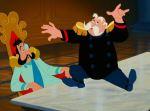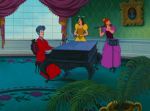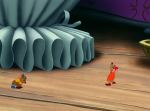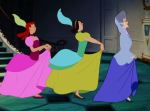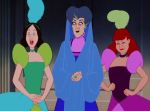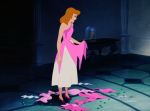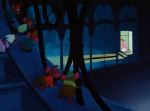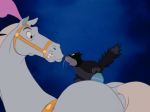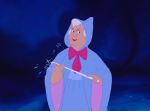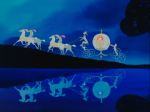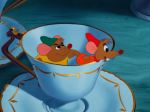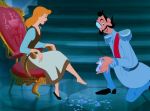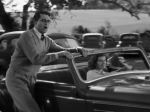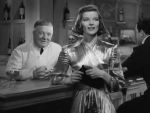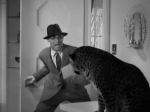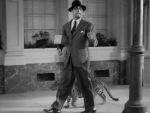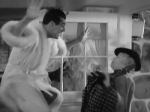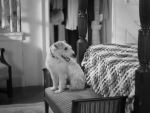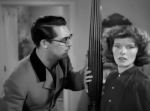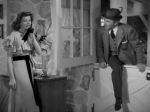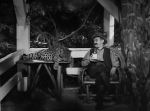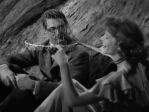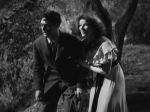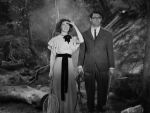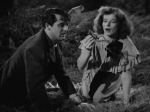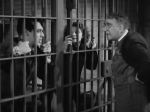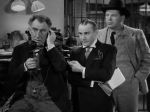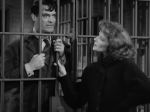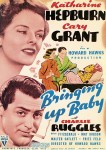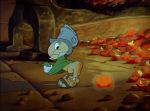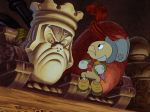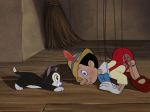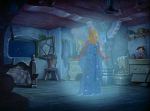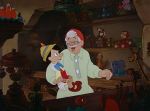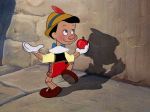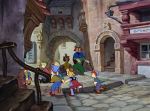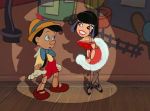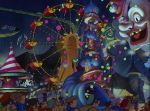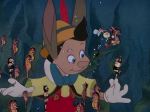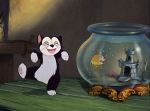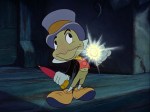Today’s cinema adventure: Life of Pi, the 2012 film adaptation of Yann Martel’s popular novel of the same name, relating the tale of a boy who, stranded by shipwreck in the middle of the Pacific, must survive alone in a lifeboat with a ferocious Bengal tiger. In development for several years, it was assigned to a number of directors before finally being offered to acclaimed filmmaker Ang Lee; under his guidance, the challenging material was shaped into a 3D blockbuster, utilizing extensive CG effects to realize the logistically daunting circumstances of its plot. Long anticipated by fans of the book, many of whom undoubtedly regarded it unlikely that an adequate film could be made from the delicate source material, it has thus far been greeted with overwhelmingly positive response by both critics and audiences, who have marveled at its visual beauty and technical wizardry, as well as expressing admiration for its handling of the novel’s important metaphysical themes.
Adapted more or less faithfully from Martel’s original by screenwriter David Magee, the film begins in Canada, with an interview between an unnamed writer and the possible subject for his new book- Piscine “Pi” Patel, a teacher from India who, as a teenager, survived the sinking of a trans-Pacific freighter and spent nearly a year adrift in a lifeboat before reaching safety on the shores of Mexico. Pi proceeds to tell his tale, first detailing his childhood in Pondicherry, India, as the younger son of a zookeeper and his wife. Exposed at an early age to not only his native Hindu religion, but also Christianity and Islam, he becomes devout in all three- though his family, particularly his father, tries to encourage him to take a more practical, scientific approach to life. Eventually, as Pi approaches adulthood, the family decides to start a new life in America; father arranges passage on a freighter, upon which they can also transport the zoo animals. Halfway through the journey, however, Pi awakens in the middle of the night to discover the ship is sinking; forced into a lifeboat by the frantic crew, he soon finds himself the only human survivor, stranded thousands of miles from land- but not quite alone. Under the canopy of the lifeboat lurks an enormous tiger, the last remaining member of his father’s menagerie. In order to survive his ordeal at sea, Pi must establish a precarious relationship with the huge carnivore, simultaneously his only companion and his greatest threat, while also learning to procure the fresh water and food they will both need in order to survive. The experiences and adventures they share form a strange bond between boy and beast, and Pi’s journey becomes a rite of passage in which he must come to terms with his place in the universe and define his relationship with the absolute.
Life of Pi is one of those movies that is exceptionally difficult to write about in any meaningful way; even a description of the plot is impossible to accomplish without either giving away key story elements or making the whole thing sound like an implausibly far-fetched boy’s adventure yarn. The film’s advertising campaign makes it clear, however, that it is a movie meant to inspire a sense of wonder, so it’s no spoiler to reveal that director Lee approaches the novel’s scenario with an eye towards capturing the mystical experience of it; and rightly so: like Hemingway’s The Old Man and the Sea, from which it clearly bears a direct lineage, Martel’s novel is as much a metaphor as a narrative, offering a portrait of inner transformation through its description of outward events. It is precisely this quality that makes the notion of transposing it to film so questionable, since translating the esoteric into a visual milieu can be problematic, to put it mildly, particularly when the outward circumstances of the story are not only limited by its setting but also extraordinarily difficult to capture on film by conventional means- the 1957 film version of Hemingway’s tale, well-acted as it may have been by Spencer Tracy, is proof enough of that. Fortunately, Life of Pi benefits immeasurably from the technological advances in filmmaking that have allowed the convincing depiction of almost anything imaginable; even more importantly, it benefits from the supervision of a truly gifted film artist who understands the importance of using all these high-tech enhancements to serve his material, rather than the other way around.
Ang Lee is an exceptional filmmaker, one who has proven time and again his particular gift for approaching Western subject matter with the perspective of his Asian background. With films like The Ice Storm and Brokeback Mountain, he has explored distinctively American subjects and settings with the cool and sensitive eye of a shrewd outsider, distilling humanity at its essence from the conflict between the cultural and personal mores of his characters; with Life of Pi, he is given the opportunity to merge these differing viewpoints in a story which draws from the elements of both. In Martel’s novel- and fortunately, in Magee’s screenplay- the literal, narrative-based traditions of the West are blended with the symbolic, inscrutable mysticism of the East, creating a story which satisfies the needs of both; it is simultaneously a tall tale and an object for meditation, an invitation to participate in both a rousing adventure and a spiritual journey, and a celebration of both the outward and inward beauties of the universe. With a keen understanding of this material, Lee once more coaxes the innermost revelations from his meticulously crafted arrangement of surface details, resulting in a remarkable film that combines his characteristic observational lyricism with the kind of shimmering magic that elevated his Crouching Tiger, Hidden Dragon from a straightforward martial arts genre picture to an unforgettable cinematic experience.
Unlike Crouching Tiger, however, Life of Pi is not exactly a fantasy picture; but Lee shoots it as if it were, giving even its most mundane settings a feeling of being larger than life. He gives us a world where everything seems to shine with an inner glow, possessed of a deeper nature just beneath its surface, and in all his settings- the streets of Pondicherry with their fusion of European and Indian influence, the lush wonderland of the zoo, the cavernous, animal-filled cargo hold of the freighter, the exotic jungle of the mysterious floating island Pi discovers late in the film, and of course the alternately idyllic-and-punishing timelessness of existence in the isolated void of the ocean- everything we see has the a priori familiarity of an archetype, a deeply-embedded subconscious memory of a place we’ve never been. This is accomplished by the surreal visual atmosphere the director achieves with the help of his artistic and technical team (particularly through the golden-hued palette captured by cinematographer Claudio Miranda and the hauntingly ethereal score by Mychael Danna), but also by a sublime artistic sense that allows him to put all the pieces together with just the right balance of dream-like ephemera and visceral tangibility.
It needs also to be observed that Ang Lee chose to make Life of Pi as a 3D movie, and though I’m not a fan of the current trend towards putting almost everything into this unnecessarily costly and often gratuitous format, his film demonstrates- like Martin Scorsese’s Hugo– what can be done with it in the hands of a truly gifted filmmaker. Lee uses the extra depth to enhance and expand our experiences in the world of his film, particularly in regard to suggesting the overlay of different perspectives and realities that is of such great importance to the thematic core of the story. Indeed, though Life of Pi can most certainly be enjoyed and appreciated in the conventional format, I might even venture to say that, at least in terms of artistic relevance to the material, it is the greatest use to date of three-dimensional technology; if at all possible, its a film that definitely warrants the extra effort and expense of an outing to your nearest 3D-equipped multiplex.
Besides the 3D effects, as mentioned before, there are many other technical aids that contribute to Life of Pi; it is safe to say the film would be impossible without them, for though most of the story’s circumstances could likely be provided by standard, pre-digital-age camera trickery, there is at least one crucial element that could probably never be realized without the help of the advanced computer wizardry on display here. I refer, of course, to the tiger- who has a name I will not reveal here, since I am loath to spoil even the smallest of the movie’s many delights. The relationship between Pi and this formidable creature is the crux of the entire film; through it comes the majority of the boy’s revelatory experience, his attempts to establish a connection to the awesome and terrifying power of the universe and come to terms with his own true nature. The beast must seem as fully alive, perhaps even more so, as his human co-star, and it is a testament to the artistry of Lee and his CG technicians that this condition is met beyond any reasonable expectation. Remarkably, the tiger’s presence is almost entirely created digitally- the only live footage comes when he is swimming, and it is virtually impossible to tell the difference. Pi’s feline companion exudes a palpable reality and a distinct personality, making him arguably the most impressive of the film’s triumphs.
The tiger’s utterly convincing presence is by no means the only triumph of Life of Pi, though, and while the beast is a display of special effects at their most dazzling level, it never overwhelms or upstages the rest of the film. Rather, the tiger plays its role alongside the flesh-and-blood human cast members so seamlessly that the film’s advertising tag line, “Believe the Unbelievable,” seems entirely apt. As for the humans, they form a superb ensemble of players, embodying their roles so perfectly as not to call attention to themselves as actors at all. As so frequently happens in a film of this magnitude, the performers are so much a part of the cohesive whole that they tend to go unnoticed, but nevertheless they deserve praise for their fine work. In particular, Bollywood actress Tabu and Anil Hussain make an impression as Pi’s mother and father, respectively, as does the lovely Shravanthi Sainath as a girl with whom the young hero enjoys a brief romance before he begins his fateful journey. As the adult Pi, Irrfan Khan (another Bollywood stalwart) is serene and approachable, yet perhaps, somehow haunted- he makes us want to hear the tale of the journey that shaped him into this enigmatic figure. As the writer to whom he tells it, Rafe Spall is appropriately likable (suitably enough for a character whose role is to stand in for the audience), but also offers a faint aura of desperation, suggesting that underlying his practical interest in Pi’s narrative as inspiration for his work is the deeper need of a spiritual seeker. As an interesting side note, Spall was cast only after actor Tobey Maguire had already completed filming his own performance in the role; Lee decided Maguire was too recognizable and his presence would call undue attention to what was essentially, though important, a minor role, and reshot all of his scenes with Spall instead. Interestingly, iconic French star Gérard Depardieu makes an appearance in another small- but ultimately significant- role as a chef aboard the freighter, making one wonder if his scenes might have been reshot for the film’s French release.
Clearly, though, the most crucial performance must come from the young actor playing 16-year old Pi, whose experiences- both exterior and interior- provide the main body of the film. Making his screen debut in the role, first-time actor Suraj Sharma rises admirably to the occasion. Chosen by Lee out of 3000 candidates, he actually attended the audition as an escort to his younger brother, but the director was taken by his appearance and asked him to try for the part; though he went through several rounds of readings, he was eventually chosen to star in the film, but before filming began he underwent extensive training- not only in acting, but in yoga and meditation practices as well as ocean survival. The resulting performance is as magnificent a film debut as any young actor could hope to deliver, requiring Sharma to portray a profound range of emotional and psychological transformations, and he does so with utter conviction- and charisma on top of that. He takes us every step of the way through Pi’s journey, without faltering for a moment. It is a superb piece of film acting, and proves that this young man fully deserves a long and active future in front of the cameras, should he choose to continue on that path.
Though I haven’t said it yet, in so many words, it should be obvious be now that I think Life of Pi is a pretty great movie. I should accompany that endorsement with the disclaimer that I am a huge fan of the book and also of Ang Lee; but even considering any personal bias, I feel pretty confident in my assessment of the film as one of the best films of 2012. No doubt there are those who might be skeptical, particularly those unfamiliar with the original book who might suspect it of bring some sort of gooey boy-and-his-tiger adventure. Rest assured, it is not. Life of Pi is the story of man’s quest to form a relationship to the mysteries of existence, to reconcile the delicate balance between life and death, and to find within himself the strength and determination to keep going in the face of the uncertain and unknowable. Like its protagonist, it draws influences from the three religious traditions mentioned above, as well as from a healthy dose of existentialism; it uses its story to explore not only themes of personal development, but of the nature of perception and reality itself. Some viewers may feel that Pi’s tale is too preposterous to be believable, and to be sure, it strains plausibility increasingly as it progresses; to that, I can only say that this is in itself a part of the film’s unusual power, and that in the end, the story’s very unlikeliness is in fact a key factor to its purpose. Ultimately, Life of Pi asks a great many questions about existence, questions that each of us must face in our own lives, but it doesn’t answer any of them; instead, it challenges us to find our own answers, leaving us puzzled and pondering, stimulated and shaken- but most of all, amazed and- just maybe- a little bit more enlightened.
Before offering a whole-hearted recommendation for Life of Pi, I must also caution that, in spite of the presence of zoo animals and its adventurous overtones, this is not a typical “family” movie; not only does it deal with the sophisticated, “heavy” themes discussed above, it also contains much that could be very upsetting to young children- indeed, even to most adults. Lee does not shy away from showing us the universe in its most chaotic, destructive, and unmerciful aspect, and though the movie contains a considerable amount of humor and counters its more terrifying content by also capturing the world in its most blissful and sublime beauty, his purpose is not to offer a comforting, sentimentalized vision of a reality in which, despite the scary parts, everything will always turn out alright. That said, there is nothing inappropriate for young people in Life of Pi, and with guidance and participation from parents, it is probably a much finer choice for family viewing than the majority of safe and formulaic pabulum churned out around the holiday season; I would recommend it heartily above such “tweener” crowd-pleasers as the latest Twilight installment. As for the rest of the film-going public, I can think of no qualification to offer with my encouragement to see this movie; it is one of those rare examples of mainstream moviemaking that successfully achieves the status of great art, and I have little doubt it will become a classic. Thus far, Life of Pi has performed respectably at the box office, though it has been predictably overshadowed in a season that also offers impressive revisitations of James Bond and Abe Lincoln– in addition, of course, to Twilight’s doe-eyed teenage vampires; let’s hope that it manages to hold its own long enough to ensure an opportunity for all fans of great cinema to experience it in its full glory on the big screen. If you miss that chance, though, it will still be worth your while to pick it up as soon as it becomes available for home release- and buy, don’t rent. This one’s a keeper.
http://www.imdb.com/title/tt0454876/




















































